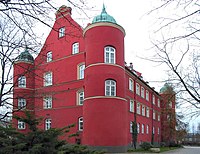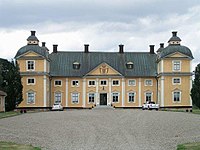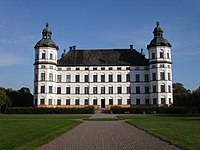| Carl Gustaf Wrangel | |
|---|---|
 Carl Gustaf Wrangel in 1662 | |
| Born | December 23, 1613 |
| Died | July 5, 1676 (aged 62) |
| Place of birth | Uppsala, Sweden |
| Place of death | Spyker on Rügen, Swedish Pomerania |
| Buried at | Skokloster, Sweden |
| Allegiance | Sweden |
| Rank | Field Marshal, Lord High Admiral, Lord High Constable |
| Commands held | Commander-in-chief of the Swedish army in Germany |
| Battles/wars |
Thirty Years War (incl. Torstenson War) War for Bremen Second Northern War Scanian War |
| Other work |
Count of Salmis, later Sölvesborg Freiherr of Lindeberg and Ludenhof Gouvernor-general of Swedish Pomerania chancellor of the University of Greifswald supreme judge in the Uppland |
Carl Gustaf Wrangel (also Carl Gustav Wrangel; 23 December 1613 – 5 July 1676) was a high-ranking Swedish noble, statesman and military commander in the Thirty Years', Torstenson, Bremen, Second Northern and Scanian Wars.
He held the ranks of a field marshal, commander-in-chief of the Swedish forces in Germany (1646–1648), and Lord High Admiral of Sweden (since 1657). Wrangel was gouvernor-general of Swedish Pomerania (1648–1652 and 1656–1676) and since 1664, Lord High Constable of Sweden and a member of the Privy Council. He held the title of a Count of Salmis until 1665, thereafter he was Count of Sölvesborg; by 1673, Wrangel's title was "Count of Sölvesborg, freiherr of Lindeberg and Ludenhof, lord of Skokloster, Bremervörde, Wrangelsburg, Spyker, Rappin, Ekebyhov, Gripenberg and Rostorp".[1][nb 1]
From 1658, Wrangel was supreme judge in Uppland, and from 1660, chancellor of the University of Greifswald. He held several estates, primarily in the Swedish dominions, where he constructed representative mansions - Wrangelsburg in Pomerania bears his name until today. Wrangel was a close friend of Charles X Gustav of Sweden.
Biography[]
Family[]
Carl Gustav Wrangel was born near Uppsala to baroness Margareta Grip av Vinäs and Herman Wrangel on 23 December 1613. By his paternal descend he was a member of the Wrangel family of Baltic German origin, branches of which settled in Sweden, Russia and Germany.
Wrangel married Anna Margareta von Haugwitz (died 20 March 1673),[2] who bore him eleven children, six of whom died very young.[3] The five children who reached adulthood were
- Carl Philipp Wrangel (died 13 April 1668 in London)[3]
- Margareta Juliana Wrangel (born 4 November 1642 during the siege of Leipzig, married to Nils Brahe the Younger, nephew of Per Brahe the Younger, on 21 December 1660)[3]
- Polidora Christiana Wrangel (born 6 November 1655 in Spyker, married to Leonard Johan Wittenberg, son of Arvid Wittenberg, in the summer of 1673)[3]
- Eleonora Sophia Wrangel (born 31 August 1651 in Wolgast,[3] married to Ernst Ludwig Freiherr von Putbus on 7 April 1678)[4]
- Augusta Aurora Wrangel (born 15 January 1658 in just conquered Frederiksodde,[3] died unmarried and without issue on 27 January 1699)[5]
Under Christina[]
At the age of twenty, Carl Gustaf Wrangel distinguished himself as a cavalry captain in the Thirty Years' War. Three years later he was colonel, and in 1638 major-general, still serving in Germany. In 1644, during the Torstenson War, he commanded a fleet at sea, which defeated the Danes at Fehmarn on 23 October.
In 1646 he returned to Germany as a Field Marshal and succeeded Lennart Torstenson as commander-in-chief of the Swedish army in Germany.[6] Under Wrangel and Turenne the allied Swedish and French armies marched and fought in Bavaria and Württemberg. After the Thirty Years' War had come to an end in 1648, he was made governor-general of Swedish Pomerania.[7] Queen Christina of Sweden created him count of Salmis in Kexholms län (Salmi and Suistamo pogosta, Käkisalmi province) in northern Karelia, Finland; and afterwards augmented his lands with barony of Lindeberg in Halland.
Under Charles X Gustav[]
Already before Christina's abdication, Wrangel became a close friend and trusted advisor of her successor, Charles X Gustav of Sweden.[7] Wrangel and Charles X Gustav had first met two weeks before the Battle of Leipzig (1642), and when Wrangel's oldest daughter was born during the siege, Charles X Gustav became her godparent.[6] Charles X Gustav created Wrangel freiherr of Ludenhof, and Lord High Admiral on 11 December 1657 - a special favour for Charles X Gustav left most of Sweden's highest offices vacant.[7]
When the Second Northern War broke out in 1655, Wrangel commanded a fleet, but in 1656 he was serving on land again and commanding, along with the "Great Elector" Frederick William I of Brandenburg, in the three days Battle of Warsaw (1656). In 1657 he invaded Jutland and in 1658 passed over the ice into the islands and took Kronborg.
When Charles X Gustav died at the end of the war, Wrangel participated in organizing the obsequies and composed the melody to a lament.[8] Also in 1660, Wrangel became chancellor of the University of Greifswald, after he had been made supreme judge in the Uppland province two years earlier.[1]
Under Charles XI[]
In 1664 he was appointed Lord High Constable of the realm, and as such he was a member of the Privy Council during the minority of Charles XI of Sweden. During the Wars for Bremen, he tried to win the city of Bremen for the Swedish crown, but was not successful: On November, 15th, 1666 he was forced to make peace, and concluded the "Peace of Habenhausen". During the Scanian War, Wrangel was commanding ineffectively owing to his broken health, and was recalled after his stepbrother Baron Waldemar Wrangel (1647–1676) had been defeated at Fehrbellin.
Illness and death[]
The hardships and injuries Wrangel suffered during his multiple campaigns, combined with unhealthy eating habits, led to Wrangel suffering from several acute and chronic illnesses for most of his life,[1] most notably gout and gallstone.[2] He was treated at several health resorts, including Spa in August 1651, Langenschwalbach in July 1662 and Pyrmont in the summer of 1668, yet without ever completely recovering.[1] In 1674, he broke down "like dead" from two strikes of hypervolemia, and his chronic diseases made it nearly impossible for him to fulfill the tasks of commanding the Swedish forces in the Scanian War.[2]
Shortly afterwards, on 25 June (OS) or 5 July (NS) 1676, Wrangel died in his Spyker Castle on Rügen, Swedish Pomerania (also spelled Spycker, now part of the Glowe municipality). His body was transferred to Stralsund and remained there throughout the siege of 1678. After the battle, Stralsund fell in Danish and Brandenburgian hands, but the Danish king and the Brandenburgian elector upon requests of Wrangel's heirs permitted the body to be transferred to Stockholm, which happened in July 1680.[4] On 1 December 1680, he was buried in the Wrangel family's crypt in Skokloster.[9] His preserved written legacy is archived in the Gamla Riksarkivet (Great Imperial Archive), Stockholm.[10]
Landowner and constructor[]
In Swedish Pomerania, Wrangel advanced to the greatest landowner.[10] There, he held the domains of Spyker (Rügen) with Baldereck,[11] Cape Arkona,[4] Klein Jasmund (now part of Dubnitz, Sassnitz), Koosdorf, Polkvitz, Ruschvitz,[11] Streu[4] and Wostevitz,[11] the former property of the Roskilde bishop centered on Ralswiek (Rügen),[12] Wrangelsburg with Krebsow, Spandowerhagen and Zarnitz, Groß Ernsthof,[11] Pritzier with Buddenhagen, Giesekenhagen, Hohendorf, Hohensee, Katzow, Netzeband[13] and Zarnowdisambiguation needed, Nonnendorf with Latzow, Lubmin and Vierow,[14] Mölschow (Usedom) with Bannemin, Mahlzow, Sauzin, Zecherin and Ziemitz,[12] Brüssow[14] and Krummin (Usedom),[15] and also the islands Greifswalder Oie and Ruden.[11] Wrangel's Amt Saatzig in Farther Pomerania was exchanged for the beforementioned Klein Jasmund, Polkvitz, Rushvitz and Wostevitz in 1653, when Farther Pomerania fell to Brandenburg.[13]
In Swedish Livonia, Wrangel held the domains of Ödenpäh,[14] Rappin and Wrangelshof,[12] with Ödenpäh and Wrangelshof exchanged for Pomeranian domains in 1653.[14] Also in Livonia, he held Luua (then Ludenhof or Luhde castle in Walk (Valga) county).[16] In Scania he held Lillö. Near Stockholm, he held Ekebyhov,[12] and in Karelia, he held Salmis county, which he exchanged for Sölvesborg county in Blekinge in 1665.[17] In Finland, he held property in Bjärnå, as well as in Skokloster in Uppland, and Rostorp and Säby in Småland. In Halland, Wrangel held the county of Lindeberg.[18] In Bremen-Verden, he held Amt Bremervörde.[19]
Wrangel built the Gripenberg palace in Säby,[19] and palaces in Bremervörde, Skokloster, Spyker, Stralsund, Wrangelsburg.[20] Wrangelsburg bears his name, it was renamed by him from "Vorwerk" on 19 September 1653.[14] His favourite, and grandest, castle was Skokloster Castle in Uppland which he created substantial collections of art and expensive weapons and exotic items.
Notes[]
- Footnotes
- ↑ In 1666, he was still addressed Count of Salmis in the treaty of Habenhausen: "Carl Gustav Wrangel / dero Königl. Maytt. und Reiche Schweden Rath / ReichsMarsch / wie auch General-Stadthalter in Pommern / und OberLandtRichter in Uplandt / Graff zu Salmis / FreyHerr zu Lindenberg und Lüdenhoff / Her: zu SchogKloster / BremerVöhrde / Wrangelsburg / Spieker / Eckebyhoff und Greiffenberg". "FriedensSchluss, Welcher Zwischen Dero Königl. Maytt. zu Schweden u. PLENIPOTENTIARIO, Und ReichsFeldtHerrn, (tit.) Herrn Carl Gustav Wrangels Hoch-Gräflicher Excellentz, Eines, und Herrn Burgermeisteren, Rath, und gemeiner Burgerschafft der Stadt BREMEN, Anderen Theils, gemachet ist im HauptQuartier zu Habenhausen, für Bremen, den 15. Novembris, Anno 1666" (in Eesti / German). Tartu: Ajalooarhiiv. The Estonian Historical Archives.. pp. 2. http://www.eha.ee/plakatid/show_img.php?id=1104&file=1104_002.png. Retrieved 15 December 2009.
- Citations
- ↑ 1.0 1.1 1.2 1.3 Asmus (2003), p.195
- ↑ 2.0 2.1 2.2 Asmus (2003), p.196
- ↑ 3.0 3.1 3.2 3.3 3.4 3.5 Asmus (2003), p.197
- ↑ 4.0 4.1 4.2 4.3 Asmus (2003), p.201
- ↑ Asmus (2003), p.221
- ↑ 6.0 6.1 Asmus&Tenhaef (2006), p.69
- ↑ 7.0 7.1 7.2 Asmus&Tenhaef (2006), p.70
- ↑ Asmus&Tenhaef (2006), pp.83-84
- ↑ Asmus (2003), p.202
- ↑ 10.0 10.1 Wartenberg (2008), p.213
- ↑ 11.0 11.1 11.2 11.3 11.4 Asmus (2003), p.217
- ↑ 12.0 12.1 12.2 12.3 Asmus (2003), p.209
- ↑ 13.0 13.1 Asmus (2003), p.203
- ↑ 14.0 14.1 14.2 14.3 14.4 Asmus (2003), p.204
- ↑ Asmus (2003), p.210
- ↑ Asmus (2003), pp.206-209
- ↑ Asmus (2003), p.205
- ↑ Asmus (2003), p.206
- ↑ 19.0 19.1 Asmus (2003), p.200
- ↑ Asmus (2003), p.198
References[]
- Asmus, Ivo (2003). "Das Testament des Grafen. Die pommerschen Besitzungen Carl Gustav Wrangels nach Tod, förmyndarräfst und Reduktion". In Asmus, Ivo; Droste, Jens E.; Olesen (in German). Gemeinsame Bekannte: Schweden und Deutschland in der Frühen Neuzeit. Berlin-Hamburg-Münster: LIT Verlag. ISBN 3-8258-7150-9.
- Asmus, Ivo; Tenhaef, Peter (2006). "Die Trauerfeier an der Universität Greifswald am 11. Mai 1660 für Karl X. Gustav von Schweden. Historische und rhetorische Aspekte". In Walter Baumgartner (in German). Ostsee-Barock. Texte und Kultur. Nordische Geschichte. 4. Berlin: LIT Verlag. pp. 59–84. ISBN 382589987.
- Wartenberg, Heiko (2008). Archivführer zur Geschichte Pommerns bis 1945. Schriften des Bundesinstituts für Kultur und Geschichte der Deutschen im Östlichen Europa. 33. Oldenbourg Wissenschaftsverlag. ISBN 3-486-58540-1.
Chisholm, Hugh, ed. (1911) "Wrangel, Karl Gustav von" Encyclopædia Britannica (11th ed.) Cambridge University Press
The original article can be found at Carl Gustaf Wrangel and the edit history here.





